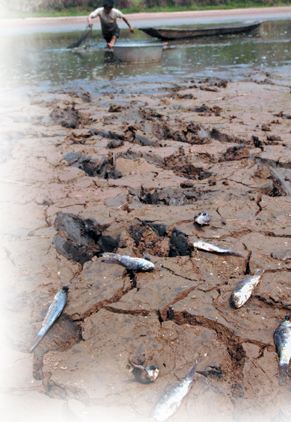Because this was an island population, emigration was not possible; the moose weakened and many died. So, in this case, the effects of bad weather on the large, dense population were greater than they would have been on a small population. (In a smaller population, the moose would have had more food available because there would have been less competition.) This situation shows that it is sometimes difficult to say that a limiting factor acts only in a density-independent way.
Human activities can also place ecological communities under stress in ways that can hamper a population's ability to recover from natural disturbance. You will learn more about that situation in the next chapter.

FIGURE 5–10 Effects of a Severe Drought on a Population Dead fish lie rotting on the banks of the once-flowing Paraná de Manaquiri River in Brazil.
Controlling Introduced Species In hydrilla's natural environment, density-dependent population limiting factors keep it under control. Perhaps plant-eating insects or fishes devour it. Or perhaps pests or diseases weaken it. Whatever the case, those limiting factors are not found in the United States. The result is runaway population growth!
Efforts at artificial density-independent control measures—such as herbicides and mechanical removal—offer only temporary solutions and are expensive. Researchers have spent decades looking for natural predators and pests of hydrillThe best means of control so far seems to be an imported fish called grass carp, which view hydrilla as an especially tasty treat. These grass carp are not native to the United States. Only sterilized grass carp can be used to control hydrilla. Can you understand why?
5.2 Assessment

-
a. Review What is a limiting factor?
Apply Concepts How do limiting factors affect the growth of populations?
-
Review List three density-dependent limiting factors.
Relate Cause and Effect What is the relationship between competition and population size?
-
Review What is a density-independent limiting factor?
Apply Concepts Give three examples of density-independent factors that could severely limit the growth of a population of bats living in a cave.
Apply the Big idea
Study the factors that limit population growth shown in Figure 5–6. Classify each factor as biotic or abiotic. (Hint: Refer to Lesson 3.1 for information on biotic and abiotic factors.)

Table of Contents
- Formulas and Equations
- Applying Formulas and Equations
- Mean, Median, and Mode
- Estimation
- Using Measurements in Calculations
- Effects of Measurement Errors
- Accuracy
- Precision
- Comparing Accuracy and Precision
- Significant Figures
- Calculating With Significant Figures
- Scientific Notation
- Calculating With Scientific Notation
- Dimensional Analysis
- Applying Dimensional Analysis




